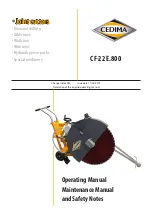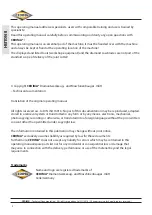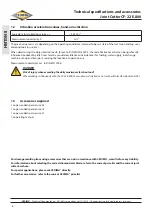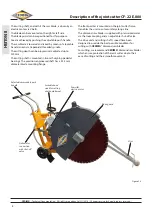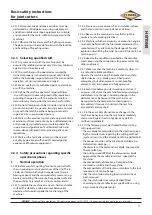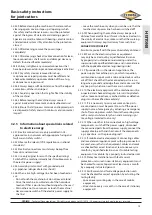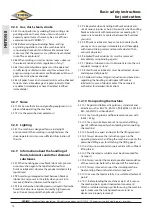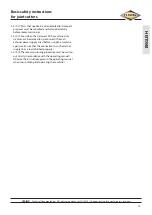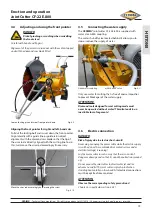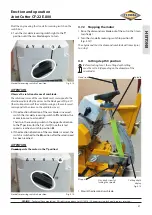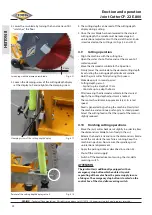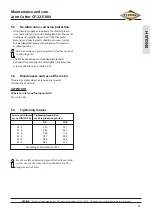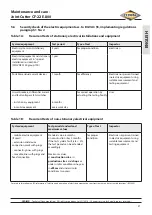
ENGLISH
12
•
CEDIMA
® • Technical Documentation • All rights reserved acc. to ISO 16016 • Changes serving technical progress reserved •
Basic safety instructions
for joint cutters
3.2.4.11 For machines driven by rotary electric power,
adhere to the direction of rotation of the tool as
specified by the manufacturer to avoid the loosening of
the tool!
3.2.4.12 During start-up and shut-down procedures always
watch the indicators in accordance with the operating
manual.
3.2.4.13 Before you start up the machine or set it to motion,
make sure that the starting or running machine does not
create any hazard to other persons’ health.
3.2.4.14 The driver/ operator position is only to be filled by
the user. Keep third parties away from the machine!
3.2.4.15 Start and operate the machine only from the
control location (CF-22 E.800, behind the machine)!
3.2.4.16 It must be ensured that the operator has
an unobstructed view of the work area at all times and
that he can intervene at any time in the working process.
3.2.4.17 Before you start working with the machine, check
that the braking, steering, signaling and lighting systems
are fully functional!
3.2.4.18 Hydraulic and water hoses as well as electric lines
must be laid in such a way that damage by crossing or by
the tool cannot occur!
3.2.4.19 The cutting operation must be performed
using the wet cutting method in order to prevent the
formation of hazardous clouds of fine dust and to
increase the service life of the cutting tool.
3.2.4.20 When using the wet-cutting method, always make
sure that there is enough water at the proper places.
Make sure there is enough cooling water at the cutting
groove!
3.2.4.21 When using the dry-cutting method, make sure
there is enough suction to remove the dust!
3.2.4.22 If substances can emerge during the work which
are health-damaging or explosive, e.g. dust, slurry, the
national health- and safety rules apply!
3.2.4.23 Moving the machine outside the workplace is only
allowed without saw blade!
3.2.4.24 When operating the machine on public roads,
ways and places always observe the traffic regulations
in force and, if necessary, make sure beforehand that
the machine complies with the relevant road vehicle
regulations.
3.2.4.25 Always control the accident-proof accommodation
of the accessories before the transport of the machine!
3.2.4.26 Never travel across slopes exceeding 5%.
3.2.4.27 Always use safety ropes when operating the
machine on sloping terrain exceeding 15%!
3.2.4.28 Before leaving the machine always secure it
against inadvertent movement and unauthorized use!
II
Special tasks when using the machine
and during upkeep work as well as
troubleshooting in daily operation;
disposal
3.2.4.29 Observe the adjustment, maintenance and
inspection activities and intervals set out in the
operating manuals, including information on the
replacement of parts or assemblies! These activities may
be performed by skilled personnel only!
3.2.4.30 Brief the operating personnel before initiating
special repair or maintenance activities! Appoint a
person to supervise such activities!
3.2.4.31 In any work concerning the operation, adaptation
to production requirements, conversion or adjustment
of the machine and its safety-oriented devices or any
work related to inspection, maintenance and repair,
always observe the start-up and shut-down procedures
described in the operating manual as well as the
instructions on maintenance activities!
3.2.4.32 If necessary, secure a large area around the
location where maintenance of the machine is to be
performed.
3.2.4.33 Service and repair work may only be carried
out with a fully lowered blade shaft/frame or through
securing the frame by means of approved trestles!
Hydraulic valves for raising the frame must be opened
(pressure relief)!
3.2.4.34 Maintenance and repair work may be carried out
only if the machine is placed on level and solid ground
and secured against inadvertent movement!
3.2.4.35 If the machine is completely shut down for
maintenance or repair work, it must be secured against
inadvertent restarting:
– remove the key and/or disconnect the power supply
– attach a warning sign at the main switch.
3.2.4.36 When using a lifting gear for replacing individual
parts or large assemblies make sure that the parts/
assemblies are carefully attached to the lifting gear
and secured in place to avoid hazardous conditions!
Use only suitable and technically perfect lifting gear
and suspension systems with adequate lifting capacity!
Never work or stand under suspended loads!
3.2.4.37 The fastening of loads and the instructing of
crane/industrial truck operators should be entrusted to
experienced persons only! The instructor must be within
sight or sound of the operator!
3.2.4.38 Before performing any maintenance/repair
activities clean the machine, especially the connectors
and screwed joints, and remove any oil, dirt and
preservative agents! Never use aggressive detergents!
Use lint-free cleaning rags!

